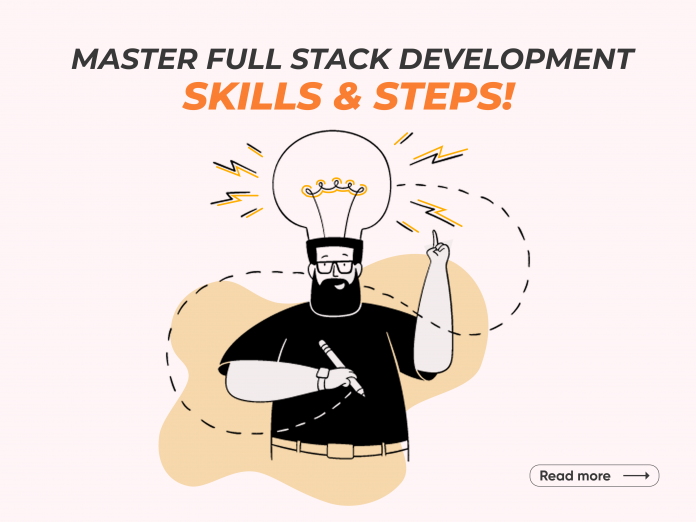In the ever-evolving landscape of technology, a Full Stack Developer has emerged as one of the most sought-after professionals. But what is a Full Stack Developer? A Full Stack Developer is an expert in both front-end and back-end development, allowing them to build complete and functional web applications. These professionals possess a diverse skill set that includes working with databases, servers, system architecture, and user interface design. Whether you are an aspiring programmer or an experienced developer looking to expand your expertise, pursuing a career as a Full Stack Developer can unlock numerous opportunities in the tech industry.
This blog provides a comprehensive guide on how to become a Full Stack Developer, detailing the essential skills, career steps, and current industry trends.
Understanding Full Stack Development
Full Stack Development involves working with both the client-side (front-end) and server-side (back-end) of web applications. Full Stack Developers possess a broad skill set, allowing them to handle databases, servers, system architecture, and user interface design. This versatility makes them highly valuable in the job market.
Front-End Development
The front-end of a website is what users interact with directly. It includes technologies like:
- HTML, CSS, and JavaScript – The fundamental building blocks of web development.
- Frontend Frameworks – Libraries like React.js, Angular, and Vue.js that simplify UI development.
- Responsive Design – Ensuring applications work seamlessly on different devices using frameworks like Bootstrap.
Back-End Development
The back-end involves handling server logic, databases, and APIs. Essential back-end technologies include:
- Programming Languages – Python, Node.js, Ruby, Java, PHP.
- Databases – MySQL, PostgreSQL, MongoDB.
- Server Management – Understanding Linux, Nginx, Apache.
Steps to Becoming a Full Stack Developer
- Learn the Basics of Web Development
Start with foundational languages such as HTML, CSS, and JavaScript. Understanding these core technologies is crucial before diving into advanced topics.
- Master Front-End Development
Gain proficiency in front-end libraries like React or Angular. Learn how to create dynamic and responsive interfaces to enhance user experience.
- Develop Back-End Skills
Learn a server-side programming language such as Python or Node.js. Understanding how to handle server requests, API integrations, and database management is essential.
- Work with Databases
Master database management with SQL and NoSQL databases. Learn how to design schemas, query data, and ensure security best practices.
- Learn Version Control and Deployment
Using Git and platforms like GitHub for version control is a must. Additionally, familiarize yourself with cloud platforms such as AWS, Firebase, or Heroku for application deployment.
- Build Projects and Gain Practical Experience
Developing real-world projects will help solidify your knowledge. Work on personal projects, contribute to open-source projects, or participate in hackathons.
- Understand DevOps and Security Best Practices
Basic knowledge of DevOps tools and security protocols ensures that your applications remain scalable and secure.
- Stay Updated with Industry Trends
Technology is constantly evolving. Keep learning new frameworks, tools, and best practices to remain competitive in the job market.
Essential Skills for Full Stack Developers
To succeed as a Full Stack Developer, mastering key technical and soft skills is essential. Here are some critical skills you should focus on:
- Proficiency in Front-End and Back-End Technologies – Strong knowledge of programming languages, frameworks, and tools.
- Database Management and Design – Ability to work with SQL and NoSQL databases effectively.
- Version Control with Git and GitHub – Collaboration and tracking changes efficiently.
- API Development and Integration – Creating and consuming RESTful and GraphQL APIs.
- Understanding of DevOps and Cloud Computing – Knowledge of AWS, Docker, and Kubernetes.
- Problem-Solving and Debugging Skills – The ability to troubleshoot and optimize code.
- Strong Communication and Team Collaboration – Working efficiently with teams to build scalable applications.
Career Opportunities and Salary Expectations
With the rise of web applications and digital platforms, Full Stack Developers are highly sought after. Some common career roles include:
- Full Stack Developer – Works on both front-end and back-end development.
- Software Engineer – Focuses on application design and functionality.
- Web Developer – Specializes in creating web-based applications.
- DevOps Engineer – Works on deployment, automation, and server management.
Salary Expectations
The average salary for Full Stack Developers varies based on experience, location, and industry:
- Entry-Level: $60,000 – $80,000 per year
- Mid-Level: $80,000 – $120,000 per year
- Senior-Level: $120,000 – $150,000 per year
Future Trends in Full Stack Development
- AI and Machine Learning Integration
With AI-driven applications becoming the norm, Full Stack Developers with knowledge of AI and machine learning frameworks such as TensorFlow and PyTorch will have a competitive edge.
- Rise of Serverless Architecture
Cloud computing is pushing the adoption of serverless computing, allowing developers to focus on code without worrying about infrastructure management. Understanding platforms like AWS Lambda and Azure Functions is beneficial.
- Progressive Web Apps (PWAs) Growth
PWAs provide a mobile-app-like experience on the web, improving user engagement. Mastering PWA development using Service Workers and WebAssembly can be a game-changer.
- Enhanced Cybersecurity Measures
Security is a growing concern in web development. Full Stack Developers with expertise in cybersecurity protocols, authentication mechanisms, and data encryption will be in high demand.
- Blockchain and Decentralized Applications (DApps)
Blockchain technology is expanding beyond cryptocurrency. Full Stack Developers who understand smart contracts and decentralized applications can tap into emerging blockchain development opportunities.
Conclusion
Becoming a Full Stack Developer requires dedication, continuous learning, and hands-on experience. By mastering both front-end and back-end technologies, gaining practical knowledge through projects, and staying updated with industry advancements, you can build a successful career in B.tech Full Stack Development. With high demand and lucrative salaries, this career path offers great opportunities for growth and professional development.
Whether you are starting your journey or looking to enhance your development skills, following a structured learning approach will help you succeed in this dynamic and rewarding field.














